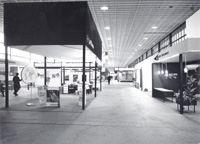
EVERY March representatives from over 180 countries and territories gather in the 26 halls on the Berlin Exhibition Grounds, testimony to the fact over the last 40 years, the International Tourism Exchange ITB Berlin has made a name as the world’s leading international travel trade fair and the largest tourism show for the general public.
Every year, over a period of only five days, the ITB generates a turnover of approximately five billion euros. The fair attracts well over a hundred thousand visitors to the German capital and is rightfully considered an international meeting place, with three-quarters of over 10,000 exhibitors from foreign countries. Close to one-third of trade visitors come from abroad to do business and to check on the latest market developments at the ITB. From the earliest days onwards rising exhibitor and visitor numbers testified to the outstanding success story of this unique tourism trade show.
Authentic stands reflecting the typical style of each country create an impressive holiday atmosphere. Trading partners from around the world finalise business for the upcoming year. Experts from every source and destination country in the world find out about the latest industry trends and discuss business strategies at the accompanying ITB Convention.
A year before the show’s 1966 debut, leading associations of the German tourism industry were less than enthusiastic about the idea of a tourism trade fair in Berlin. The archives at Messe Berlin contain correspondence urgently advising against ‘an exchange for tourism’, considering there to be ‘absolutely no reason for it’. In contrast, the local daily Berliner Morgenpost said the idea of a ‘travel exhibition’ was ‘extremely novel’, particularly in view of the limited travel options open to West Berliners, but rated the chances of an all-German trade fair much higher than an international exhibition. Unfazed, ITB Berlin founder Prof Dr Manfred Busche launched the fair in 1966, as part of an exhibition for overseas imports. Nine exhibitors from five countries, Egypt, Brazil, the Federal Republic of Germany, Guinea and Iraq, displayed their products to 250 trade visitors over 580 sqm. A seminar held alongside debated new holiday destinations on new continents.
The second show, in 1968, was a much bigger success, boosted by a sudden rise in holiday choices for the consumer and a fast growth in the number of organisations in the tourism sector. Teamed with the International Boat and Leisure Show Berlin, ITB grew to ten times the size, attracting 1,250 trade visitors and 123,500 Berliners. It was the Cold War era, two Iron Curtain states were at the fair: Romania and Hungary. In the years since, ITB continued to be a platform reaching out across the political divide, as exhibitors from East Germany or the Soviet Union exhibited side by side, as did their colleagues from Egypt and Israel during the Six Days War.
At 13,400 sqm, exhibition space reached five digits for the first time in 1972, and in 1974 the 20,000 mark was exceeded. In 1980 the size of ITB had reached almost 52,500 sqm, and it was separated from the boat show. Nowadays the 150,000 sqm of the 26 halls on the Berlin Exhibition Grounds are fully booked up.
New themes and new types of travel
The forerunner of the entire tourism sector, ITB has established itself as an event not to be missed by the big international tourism associations and as a marketing opportunity for tourism companies. The world’s largest travel trade fair anticipates new market trends and is always putting new ideas into practice. Organising the halls by countries and later on introducing individual market sections gave a clearer picture of the world of tourism. The fair mirrors society trends and economic developments. During the ’80s criticisms surfaced questioning the problematic aspects of tourism, leading to new and alternative forms of tourism. Whether it was gentle forms of travel or health tourism in the ’90s, later on wellness, ITB Berlin gave them all a platform and helped them gain shape.
By 1985 business travel was already an important theme at ITB. In 2006 the ITB Business Travel Days cover everything this segment has to offer on all five days of the fair, including a broad range of training and education opportunities. Today ITB offers travel for every type of consumer, young people, the elderly, the disabled, families or hikers.
The introduction of new technologies has always been at the forefront. Since 2000 products by exhibitors in the Travel Technology segment have been mirroring technological progress. A growing internet travel market has sparked radical changes in this field. Together with US-based technology market research organisation and consultancy PhoCusWright, meetings are taking place this year under the moniker Travdex@ITB to discuss trends from the USA and how to adapt them to European needs.
Since 2004 the ITB Berlin has hosted the world’s largest tourism convention, the ITB Convention Market Trends & Innovations. True to its name it has organised a whole variety of events on topics including aviation, the hotel business and marketing tourism, discussing the latest trends and their influence on tourism worldwide.
